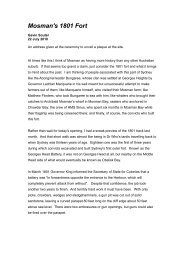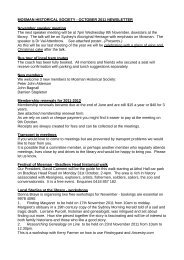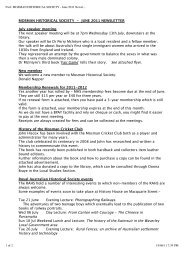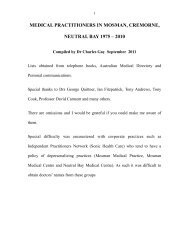Historic Guide to Bradleys Head - Mosman Historical Society
Historic Guide to Bradleys Head - Mosman Historical Society
Historic Guide to Bradleys Head - Mosman Historical Society
You also want an ePaper? Increase the reach of your titles
YUMPU automatically turns print PDFs into web optimized ePapers that Google loves.
HISTORIC GUIDE TO<br />
THE<br />
BRADLEYS HEAD<br />
AREA<br />
The brochure is designed for those who follow in<br />
any direction the sign posted walking tracks with<br />
glorious harbour views that link <strong>Bradleys</strong> <strong>Head</strong><br />
with Little Sirius Cove and Taylors Bay.<br />
Paid parking areas are at Little Sirius Cove, near<br />
the Athol Hall Function Centre and at the end of<br />
<strong>Bradleys</strong> <strong>Head</strong> Road. Buses connect various<br />
locations with Taronga Zoo and Taronga Zoo<br />
Wharf. There are regular ferry services between<br />
the wharf and Circular Quay.<br />
<strong>Mosman</strong> Library’s Local Studies Collection holds<br />
materials on the his<strong>to</strong>ry of the <strong>Bradleys</strong> <strong>Head</strong> area.<br />
The Aborigines belonged <strong>to</strong> the Borogegal<br />
clan of the Eora nation. In 1789, a smallpox<br />
epidemic killed many of the Aborigines living<br />
around Sydney Harbour.<br />
Athol Bay, originally called Sandy Bay, is a<br />
safe deepwater anchorage. In 1831, Robert Millard<br />
and Richard Linley were permitted <strong>to</strong> use four<br />
acres of land, named Point Pleasant, at Whiting<br />
Beach, Sandy Bay, <strong>to</strong> build a shipyard and eight<br />
years later, they were issued a deed of grant. No<br />
ships, however, were built there. The Ferrier<br />
family constructed a five-room s<strong>to</strong>ne house called<br />
‘Athol’, with a wharf, two wells, an orchard and<br />
gardens, in 1837. The family retained the property<br />
until 1904 but after 1853, it was let <strong>to</strong> tenants. In<br />
1840, Mrs Mary Hanson was granted four acres<br />
east of Point Pleasant and in the following year,<br />
Linley transferred his interest <strong>to</strong> Millard. The<br />
Crown resumed Point Pleasant for defence<br />
purposes in 1871. In 1912, a 42-acre site on Athol<br />
Bay was rededicated for use as a zoological park.<br />
A ferry wharf served by a tramline opened near the<br />
new zoo in 1917. On 3 November 1927, Greycliffe<br />
sank in Sydney Harbour after a collision with<br />
Tahiti, resulting in 42 deaths. The wreckage was<br />
later hauled up on <strong>to</strong> Whiting Beach. During the<br />
Second World War, the giant troopships Queen<br />
Mary and Queen Elizabeth anchored at Athol Bay.<br />
For many years after the war, old Australian<br />
warships were located in the bay before being<br />
scrapped.<br />
Athol Hall was built on the site of an earlier<br />
dance hall in 1908. The nearby Athol Arms (later<br />
Athol Gardens) Hotel, very close <strong>to</strong> the present<br />
parking area, was first recorded in 1863, later<br />
being extended. The lawns surrounding the hall<br />
comprised a well known ‘pleasure garden’. J.T.<br />
Coffill <strong>to</strong>ok over the Athol Gardens Hotel and<br />
Pleasure Gardens in 1880. Two years later, though,<br />
it lost its dancing permission and licence. It<br />
became the Athol Temperance Hotel. Sydney<br />
Ferries acquired Athol Gardens in 1906.<br />
<strong>Bradleys</strong> <strong>Head</strong> was known <strong>to</strong> Aboriginal<br />
people as Borogegy, Booraghee, Booragy or<br />
Burrogy. Its present name is after Lieutenant<br />
William Bradley of HMS Sirius, the First Fleet<br />
flagship. In 1788, he referred <strong>to</strong> ‘Bradley Point’.<br />
The Crown acquired much of the area for military<br />
purposes. Military construction work commenced<br />
in 1839-1841 with a s<strong>to</strong>ne jetty and a circular<br />
sands<strong>to</strong>ne gun pit, both of which still stand at the<br />
end of <strong>Bradleys</strong> <strong>Head</strong>. <strong>Bradleys</strong> <strong>Head</strong> Road, an<br />
extension of Military Road, was originally a level<br />
path for horse drawn vehicles <strong>to</strong> service the<br />
fortifications. Gun emplacements and a sands<strong>to</strong>ne<br />
firing gallery located near the end of <strong>Bradleys</strong><br />
<strong>Head</strong> Road were built in 1871. In the same year,<br />
the s<strong>to</strong>ne column from the first Sydney General<br />
Post Office façade, which was demolished in 1863,<br />
was erected near the jetty <strong>to</strong> mark a nautical mile<br />
from Fort Denison. It provided accurate sea trial<br />
1
measurements, allowing the speed of newly<br />
constructed ships <strong>to</strong> be checked. The jetty supplied<br />
soldiers stationed at the fortifications. In 1895, T.S.<br />
Huntley acquired mineral leases between <strong>Bradleys</strong><br />
<strong>Head</strong> and Athol Gardens. A coal-mining site, near<br />
Athol Hall, was cleared and levelled but due <strong>to</strong><br />
public protests, no mining was allowed. An electric<br />
beacon with a foghorn was erected at the southern<br />
end of the <strong>Head</strong> in 1905. In 1908, Ash<strong>to</strong>n Park was<br />
proclaimed. It included 142 acres at <strong>Bradleys</strong> <strong>Head</strong><br />
and was named after James Ash<strong>to</strong>n, New South<br />
Wales Minister for Lands. The tripod foremast and<br />
fire control <strong>to</strong>wer of HMAS Sydney, the Australian<br />
warship that sank the German raider Emden in<br />
1914 and which was broken up in 1928, was<br />
erected in 1934 <strong>to</strong> coincide with His Royal<br />
Highness the Duke of Gloucester’s visit <strong>to</strong> Sydney.<br />
The dedication and playing of the national anthem<br />
were timed <strong>to</strong> occur as he sailed past on his way <strong>to</strong><br />
a surf carnival in Manly. A degaussing station<br />
s<strong>to</strong>od on the beach on the eastern side of <strong>Bradleys</strong><br />
<strong>Head</strong> during the Second World War. It was used <strong>to</strong><br />
neutralise the magnetisation of ships. A bitumen<br />
road was built through Ash<strong>to</strong>n Park in 1964.<br />
During the 1960s and 1970s the sisters Joan and<br />
Eileen Bradley (no relation <strong>to</strong> William Bradley),<br />
who lived very close <strong>to</strong> the park and spent much<br />
time in it, developed the widely acclaimed Bradley<br />
bushland regeneration system. Ash<strong>to</strong>n Park<br />
became part of Sydney Harbour National Park in<br />
1975. The producers of the 2000 film Mission<br />
Impossible 2 built the amphitheatre at <strong>Bradleys</strong><br />
<strong>Head</strong> after they used its site <strong>to</strong> erect a polystyrene<br />
house from which the ac<strong>to</strong>r Tom Cruise after<br />
landing at the jetty could rescue a girl being held<br />
hostage.<br />
Curlew Camp, the site of which is reached on<br />
the clearly signposted track on Little Sirius Cove’s<br />
eastern shore, existed from 1890 <strong>to</strong> 1912. Its<br />
founder was the clothing manufacturer Reuben<br />
Brasch. Famous Australian painters Tom Roberts<br />
and Arthur Stree<strong>to</strong>n first came there in 1890,<br />
making frequent return visits. They and other wellknown<br />
Australian artists lived in tents along the<br />
foreshore and painted the beautiful harbour<br />
scenery. They belonged <strong>to</strong> the ‘Heidelberg<br />
School’, which was greatly influenced by French<br />
impressionism and favoured painting in the open<br />
air <strong>to</strong> capture the Australian landscape’s light and<br />
colour. The camp had a dining hall, a billiards tent<br />
and well-maintained gardens. A pathway was built<br />
<strong>to</strong> access it. Some of the tents were filled with<br />
heavy and ornate furniture. Roberts and Stree<strong>to</strong>n<br />
left the camp for the last time in 1896. It closed<br />
when the decision was made <strong>to</strong> create Taronga<br />
Zoo.<br />
Flora and fauna are much the same as they<br />
were before Sydney’s establishment. The area is<br />
the home of many native animals and birds,<br />
including some endangered species.<br />
Little Sirius Cove, which is well viewed<br />
from Curlew Camp, was named after HMS Sirius,<br />
a 20-gun frigate that was flagship of the First Fleet,<br />
which arrived in Sydney Harbour in 1788. Great<br />
Sirius Cove was an early name for the southern<br />
portion of nearby <strong>Mosman</strong> Bay.<br />
Taronga Zoo opened as a ‘zoological garden’<br />
in 1916 and now has more than 2,000 animals from<br />
around the world. It replaced the previous<br />
government zoo established at Moore Park in<br />
1880. Many of the animals came by vehicular ferry<br />
from Moore Park. Jessie, a four <strong>to</strong>n elephant, who<br />
had been out of Moore Park only once in 34 years,<br />
walked <strong>to</strong> Circular Quay in 45 minutes and crossed<br />
on a boat quietly. In 1916, a tram service started<br />
from <strong>Mosman</strong> Junction <strong>to</strong> the zoo and in 1917, it<br />
was extended <strong>to</strong> Taronga Zoo Wharf. Taronga’s<br />
lower entrance and aquarium opened in 1927.<br />
Taylors Bay was named after the fisherman<br />
Joseph Taylor who lived there earlier than 1838,<br />
when its patch of sand was called Taylors Beach.<br />
The steamer Centennial was wrecked in the bay in<br />
1889 after colliding with another vessel. In 1942,<br />
Royal Australian Navy patrol boats cornered and<br />
sunk by depth charges in the bay one of the three<br />
Japanese midget submarines involved in the daring<br />
attack on Sydney Harbour. The largest house<br />
overlooking Taylors Bay is The Manor, or<br />
‘Bakewell’s Folly’, on the corner of Iluka and<br />
Morella Roads, which can be seen clearly from the<br />
eastern side of <strong>Bradleys</strong> <strong>Head</strong>. Built by William<br />
Bakewell for his family, it was completed by about<br />
1914 and had 45 rooms. From 1922 until the<br />
present, it has been the home of a Theosophist<br />
community, which seeks <strong>to</strong> find God and achieve<br />
universal goodwill by spiritual ecstasy, direct<br />
intuition or special individual relations. In 1926,<br />
the Theosophical Broadcasting Station Pty Ltd,<br />
called 2GB, was established at The Manor and<br />
operated there for a short time before moving <strong>to</strong><br />
the city.<br />
This work has been assisted by funds allocated <strong>to</strong> the<br />
Royal Australian <strong>His<strong>to</strong>ric</strong>al <strong>Society</strong> by Arts NSW. It was<br />
compiled and published by <strong>Mosman</strong> <strong>His<strong>to</strong>ric</strong>al <strong>Society</strong>, PO<br />
Box 39, <strong>Mosman</strong> NSW 2088 in 2010.<br />
2








